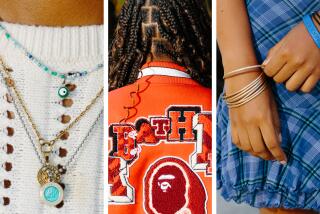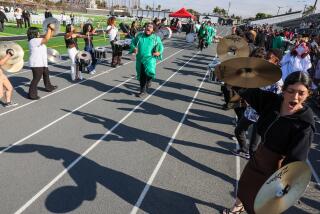True to Their Schools--and Themselves
- Share via
WASHINGTON — Cristina Williams, 17, who visits her mother’s homeland almost every year, chose a flag of Spain. Vietnamese American Jennifer Nguyen, 16, picked a dragon. Marcela Rivera, 17, chose the colors of the flag of her native Colombia.
This is the class ring, 21st century-style. Once the picture of tradition, with an engraving of the high school seal and mascot, the high school class ring has turned into the “me” ring: an expression of individuality, a symbol of what each student values.
And on increasingly diverse campuses, that individuality is often linked to a student’s foreign heritage. “Even though I was born here, I’m still Vietnamese and I want to keep [in touch] with that side of me,” Nguyen explained.
“In a major metropolitan area, school spirit is not quite the same as in a place where the school is the social vehicle,” said John Porter, principal of T.C. Williams High School in Alexandria, Va.
Sociologists say these foreign-born youngsters and first-generation Americans are not choosing their heritage instead of their schools: When they buy the ring--and buy into a cherished American tradition--they are showing loyalty to their heritage and their schools.
“They’re taking old styles and finding what they like and adding to it multiculturalism,” said William Strauss, co-author of the book “Millennials Rising: The Next Great Generation.”
“I have school pride and all, but I just like keeping in touch with my Asian culture,” said Alice Kim, a junior at Bishop O’Connell High School in Arlington, Va. Alice, born in the United States to parents who grew up in Korea, recently ordered a ring with a dragon etched into one side and the school mascot on the other.
All rings looked alike until the 1970s, dealers say, when local jewelry outlets began offering their own merchandise to compete with the larger, national companies that had a monopoly in schools. These stores, without the burden of mass production, could customize rings. That forced the larger companies, such as Herff Jones and Balfour, to offer a choice of stones, metals and widths of the band.
By 2000, educators and ring manufacturers said, community ties to schools had become weaker. Class rings had become less popular in general, so manufacturers had to be more creative. Technology had improved, paving the way to create hundreds of designs. Now students can put just about anything on a class ring: flags of Cuba and Colombia, peace signs, happy faces, mariachis, shamrocks, a picture of Martin Luther King Jr., a Star of David.
Enjoy snowboarding? Rock ‘n’ roll? Martial arts? One of the many ring companies out there can probably design a band to show it. Students can even log on to ring company Web sites to design and preview their rings.
“You can be your true self instead of doing what everyone else is doing,” said Mark Eisenbrey, a junior at O’Connell who enjoys hunting and plans to go duck hunting soon. What better way to show that than to have a duck swimming in a pond on one side of his ring?
Customization has reached a fever pitch in recent years, with only prices keeping students from going all out. A ring can cost as little as $100 but can top $500, depending on the customization.
At O’Connell High recently, dozens of students picked out their rings as carefully as a couple choosing an engagement ring. O’Connell requires that the seal or mascot appear on one side of the ring; the rest is a free-for-all.
The Spanish flag on Cristina Williams’ ring is paired with a basketball hoop with her number, 21. “This ring describes everything in me and what I am about,” she said.
At Williams, Vicky Rodriguez gave her ring a distinctive Latin American flavor. Inside the stone is an image of the Virgin Mary, “to keep myself protected,” said Rodriguez, 18. One side of the band shows the mascot of Williams High; the other features the flag of El Salvador, her parents’ birthplace. “I’m very proud of where I came from,” she said.
More to Read
Sign up for Essential California
The most important California stories and recommendations in your inbox every morning.
You may occasionally receive promotional content from the Los Angeles Times.













